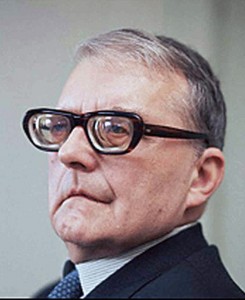
Dmitri Shostakovich lived most of his life with his head on a chopping block. Dating from Pravda’s infamous 1936 “Muddle Instead of Music” denunciation of his opera Lady Macbeth of the Mtsensk District (“I’m Uncle Joe Stalin, and I approve this message”), one of Russia’s greatest and most influential composers never knew if the next knock on the door was going to be the postman or a goon squad. Denounced, “rehabilitated,” denounced again, “rehabilitated” again: It was a decades-long roller-coaster of devastating public humiliation and supreme artistic triumph.
So his chain-smoking, OCD and constant facial tics came to him naturally.
This unlivable situation that had to be lived through, this untenable position of blinding creativity and total dread, is a tale that launched a thousand dissertations. A tragicomedy worthy of Beckett, Shostakovich did his best to remain in the good graces of the Communist Party while negotiating with himself as to just how far he could let his creative genius wander.
Attempts to place Shostakovich on one political side or another have equally vociferous advocates. Suspicions that the world’s image of him as a faithful communist were propagandistically driven were given a substantial boost by Solomon Volkov’s book Testimony (1979). Testimony makes the case for Dissident Shostakovich, the musician who hid within his works poison darts aimed at the communist system, leaving clues beyond the grasp of apparatchiks, discernible only to like-minded musicologists. In this version, he is a silent dissident secreting out coded messages to the West.
The Chicago Symphony Orchestra performs Shostakovich’s Symphony No. 11 (The Year 1905) in concerts Dec. 4-9 under guest conductor Ingo Metzmacher.
Testimony was denounced itself, though. While the book is nominally the composer’s “as told to” memoirs — comprised of interviews conducted between 1971 and 1974 —its authenticity has been forcefully challenged (a young musicologist named Laurel Fay played devil’s advocate). She offered a damning assessment of the work as a collection of rehashed gossip, recycled interviews and spurious claims. Initially (and expectedly), the Soviet Union dismissed Testimony as a forgery. Evidence for the prosecution: in his rehabilitation phases, the composer received numerous official accolades. He read speeches and signed articles adhering to the party line. He publicly denounced both Andrei Sakharov and Igor Stravinsky. In this version, the Soviet authorities considered him a “yurodivy,” a holy fool, treated as a crazy genius doing his stumbling best to fit in with society and frequently useful for demonstrating the glories and supremacy of Soviet creativity. In other words, he was an “artist,” and you know what they’re like, right?
Shostakovich officially joined the Communist Party in 1960. As for whether he did so out of fear, or career advancement, or because through time he became a true believer, the sheer volume of contradictory evidence makes it extraordinarily difficult to locate Shostakovich’s motivation, apart from simply wanting to continue composing. Conformist? Cold War double-agent (music division)? The Volkov and Fay camps continue to eye each other warily.
This ambiguity draws our attention. Beneath the music is a disquieting lack of assurance regarding his intentions. A random listener may easily hear selected works of his and read them either as a statement of firm allegiance or of acid-tongued dissent, depending upon any number of factors.
The poles are rarely more apparent than while listening to his Symphony No. 11. On its surface, the work marks the 50th anniversary of the First Russian Revolution, specifically the massacre that took place before the palace of Tsar Nicholas II on Jan. 9, 1905. On that day, Cossacks gunned down more than 1,000 impoverished Russians who just moments earlier were singing hymns with the expectation of peacefully delivering a petition to be heard by the Tsar.
Shostakovich’s father was one of the massacre’s survivors and the story loomed large in their household. As the 50th anniversary approached, the Soviet authorities offered the composer a commission to commemorate the event. With some understandable trepidation, he accepted, though it took time for him to begin.
What he ultimately delivered is a vivid paean to the revolutionary spirit, infused with hymnal grace and military brutality. It’s shocking in its depiction of barbaric cruelty, inspiring in its defiant tone that promises the people’s eventual victory over power-mad tyranny.
Which begs the question: which people and which tyranny?
Today, general consensus holds that Shostakovich was prompted to complete the work not out of loyalty to party, but out of outrage at an equally horrific and much more recent atrocity: that of Oct. 25, 1956, when more than 600 Hungarians protesting in Budapest’s Parliament Square were machine-gunned by Hungary’s Soviet-installed puppet regime. Soviet tanks rolled in soon after to squelch further protests. History repeats itself, and the composer saw an opportunity to attack in the form of praise.
At the premiere, Shostakovich’s son is said to have asked, “Papa, what if they hang you for this?” He needn’t have worried. The symphony’s cinematic appeal, and its canonization of The People, covered the multitude of deceptions, if deceptions there be. The composer was awarded the Lenin Prize for the work, and the USSR’s Central Committee issued a formal declaration that the composer’s 1948 denunciation was in error.
He had been restored to official favor. Again.
Peter Lefevre, based in California, writes about music for the Orange County Register and Opera News.
TOP: Ilya Repin’s painting Demonstration on Oct. 17, 1905, depicts a skirmish in the 1905 Russian Revolution.
